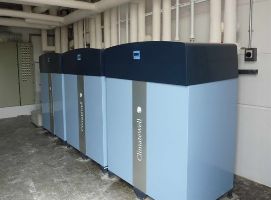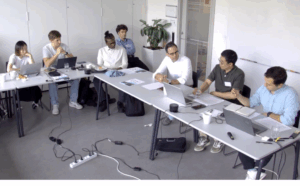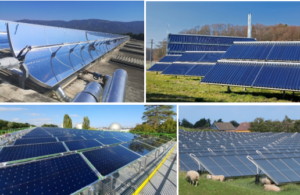Sweden: Solar Electricity, Heating, and Cooling for a local Hospital
July 1, 2010
![]() Electricity, heating and cooling from one and the same energy plant, all simultaneously: this is the special feature of the recently inaugurated solar installation at the Närvård Härnösand hospital.
Electricity, heating and cooling from one and the same energy plant, all simultaneously: this is the special feature of the recently inaugurated solar installation at the Närvård Härnösand hospital.
Photo: Cleantech Demonstration Arena
The installation at the local hospital in Härnösand, a small town on the Härnön Island off the west coast of Sweden, was inaugurated in May 2010 and financed by the Foundation for Research on Concentrated Solar Energy (Stiftelsen för forskning om koncentrerad solenergi), with the help of EU-funds. The total budget for the demonstration project, including a room for visitors and public relations, was EUR 400,000. The main components of the system include concentrating PV/T collectors by Swedish company Absolicon and an absorption chiller CW 10 from Climatewell – produced in Spain.
“The solar electricity, heating and cooling system inaugurated in May 2010 by the county mayor is the first of its kind in the world,” Joakim Byström, CEO of Absolicon, claims. Absolicon was founded 2007 to commercialize the Absolicon X10 collector developed over a period of eight years. “Originally, we wanted to develop a concentrating PV system, but the costs were too high, so we ended up using the heat as well,” explains Byström. The big advantage: Concentrating solar PV/T systems have higher efficiency and lower manufacturing costs, especially in large volumes.
The Absolicon X10 was designed for large buildings with a central heating system, such as hotels, hospitals, factories or blocks of flats. A hand full of demonstration projects have already been realized over the last two years.
The market-ready PV/T collector consists of a silver reflector protected from the elements by a glass cover and an east-west tracking unit. The receiver consists of modified solar cells, which can withstand twentyfold concentration and are connected to a collector made of metal. The water running through this collector can be heated up to 75 °C if the flow rate is low.
The connection between the cells and the metal absorber is the key feature of the newly developed collector. The tedlar foil commonly used for cells laminated to glass or metal sheets possesses a low heat conductivity, which is why Absolicon developed an alternative process that they do not wish to make public.
However, what they speak about openly is the output of the system: 20% of the energy is generated in the form of electricity and 80% in form of heat. Other advantages Byström mentioned of his product are a significantly lower use of copper and silicon, the possibility to change the receiver if cell efficiency should improve in the future and the wind safe position, in which the collector can withstand any type of storm. Absolicon X10 also possesses a Solar Keymark certification.
 Pleased with the solar cooling demonstration plant: Jan Lindberg, Energy Controller at the County Council of Västernorrland, in which the small town of Härnösand with the hospital is located, stands in front of the Climatewell Chiller.
Pleased with the solar cooling demonstration plant: Jan Lindberg, Energy Controller at the County Council of Västernorrland, in which the small town of Härnösand with the hospital is located, stands in front of the Climatewell Chiller.
Photo: Absolicon
4 units of 10 m2 Absolicon X10 were installed on the roof hospital to power the Climatewell 10 chiller. One of the goals of the R&D project is to determine the extent to which solar energy is going to contribute to covering the hospital’s heating and cooling needs. The system consists of a tank with dry salt integrated in the chiller unit and a tank with cold water, which will then be distributed throughout the building. According to Absolicon’s CEO Byström, the system produces heat and electricity at the cost of 0.11 EUR/kWh if the 60 % investment grant by the government is considered in the calculation.
More information:
The Foundation for Research on Concentrated Solar Energy: http://www.lumicum.se/foundation_eng.php
Absolicon: http://www.absolicon.com/
Climatewell: http://www.climatewell.com


